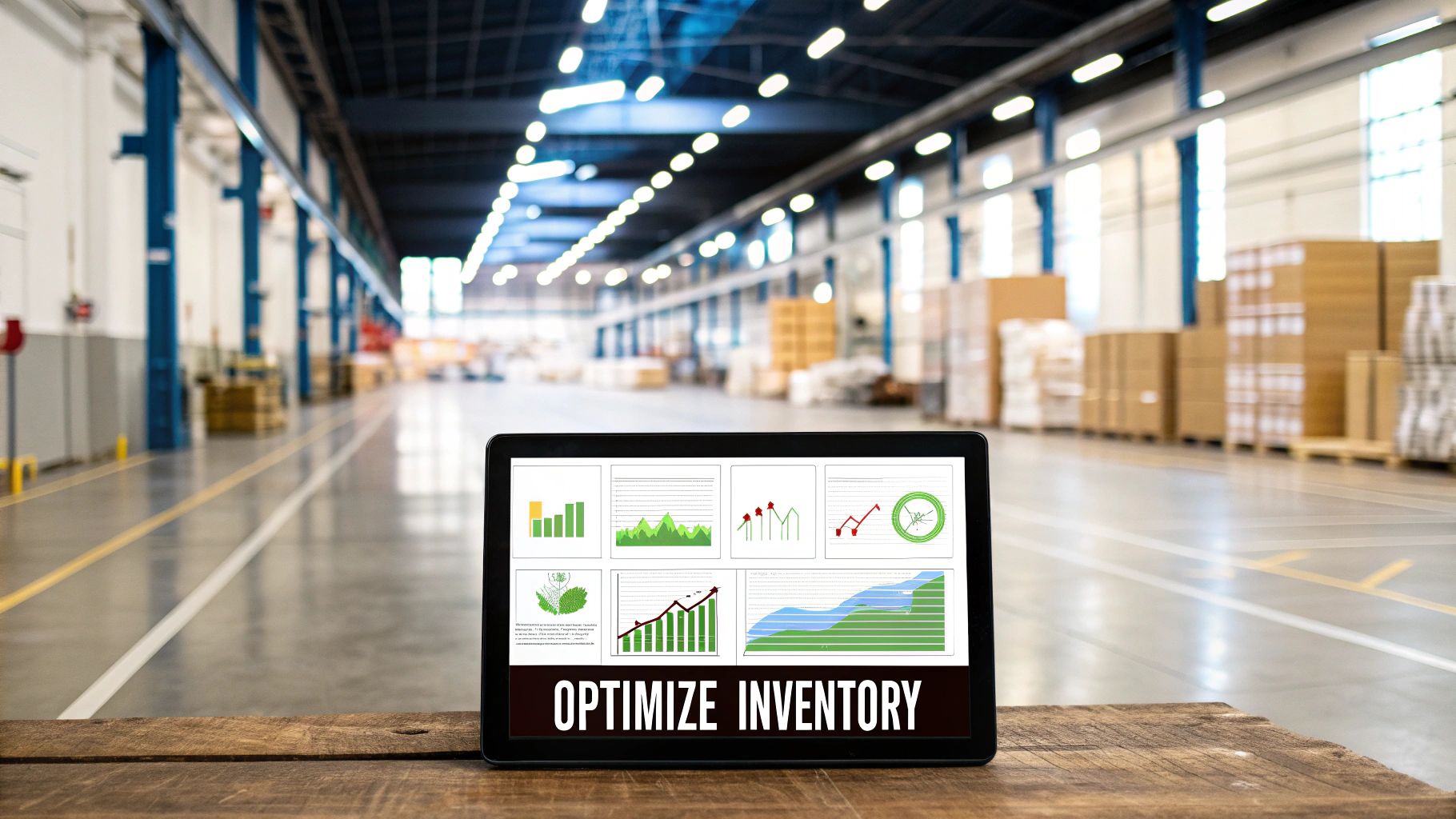The Evolution of Modern Inventory Intelligence

Remember the days of painstaking manual inventory counts and the uncertainty of relying on intuition for ordering? These outdated methods frequently resulted in costly overstocking or disruptive stockouts. Relying on guesswork instead of concrete data hindered both efficiency and responsiveness.
Thankfully, inventory management has come a long way. Businesses are now moving away from static spreadsheets and embracing dynamic, data-driven inventory management systems. This shift is fundamentally changing how supply chains operate globally.
From Reactive to Proactive: The Power of Real-Time Data
The driving force behind this evolution is the increasing accessibility of real-time data. Companies are using analytics to forecast demand with unprecedented accuracy.
Consider a clothing retailer preparing for the winter season. With data-driven inventory management, they can analyze past sales trends, current weather patterns, and even social media activity to predict which items will be most popular. This allows them to optimize stock levels, minimizing the risk of lost sales due to stockouts.
These systems can also automate reordering processes, ensuring that in-demand items remain consistently available. This proactive approach is a significant departure from traditional reactive methods, which often addressed stockouts only after they occurred.
This transition is especially critical in rapidly expanding markets like the UK. Data-driven inventory management has become essential for businesses operating there. The UK supply chain management market is expected to reach USD 4.6 billion by 2033, a significant increase from USD 1.7 billion in 2024.
This represents a substantial CAGR of 11.90% from 2025 to 2033. This impressive growth is powered by advancements in technologies like AI and big data analytics, which significantly improve supply chain visibility and informed decision-making. For a deeper dive into these statistics, see: UK Supply Chain Management Market Statistics. This growth highlights the growing need for agile and scalable inventory systems.
The Competitive Advantage of Data-Driven Inventory Management
The advantages of data-driven inventory management go beyond simply preventing stockouts. These systems provide valuable insights into customer behavior, empowering businesses to personalize their offerings and enhance the overall customer experience.
Data analysis can reveal which products are frequently purchased together, enabling retailers to offer bundled deals or targeted promotions. This deeper understanding of customer preferences translates into increased sales and stronger customer loyalty, creating a significant competitive advantage.
Technology as the Enabler: Embracing the Future of Inventory
The shift toward data-driven inventory management is facilitated by a variety of innovative technologies. Cloud-based solutions offer accessibility and scalability, while IoT sensors and RFID systems provide real-time visibility into inventory levels throughout the entire supply chain.
These technologies empower businesses to optimize inventory, reduce costs, and improve customer satisfaction in ways previously impossible with traditional methods. In today’s competitive business environment, embracing these technologies is essential for survival and growth.
Winning the Inventory Accuracy Battle
Inaccurate inventory can quietly drain a business's resources, impacting everything from customer satisfaction to the bottom line. It's like using the wrong ingredients in a recipe – you might get something, but not what you planned. This section explores the hidden costs and root causes of these inventory discrepancies, and how data-driven inventory management offers a solution.
The High Cost of Inaccuracy
The consequences of inaccurate inventory can spread throughout a business. Lost sales from stockouts are an immediate impact. Overstocking, on the other hand, leads to higher carrying costs, tying up capital that could be used more effectively. Inaccurate inventory also complicates forecasting, leading to poor purchasing decisions and missed opportunities. Ultimately, these issues can damage profitability and weaken a company’s competitive advantage.
Inventory accuracy poses a significant challenge for many retailers, with almost 60% operating with less than 80% accuracy. This often results from outdated data from POS and ERP systems, which can lead to order cancellations due to overselling. In fact, roughly 40% of retailers cancel at least one in ten orders due to inaccurate inventory data, impacting customer trust and highlighting operational inefficiencies. Learn more about how inventory accuracy boosts customer confidence here. Modern order and inventory management systems provide real-time inventory visibility, helping retailers avoid both overselling and underselling. This also ensures that marketing and advertising campaigns accurately reflect available stock, maximizing the return on ad spend.
Diagnosing the Root Causes
Understanding the root causes of inventory inaccuracy is the first step towards a solution. These causes can vary, from manual data entry errors and inadequate tracking systems to poor warehouse organization. Data-driven inventory management can help pinpoint these issues by providing detailed insights into inventory flow.
Cycle Counting: A Data-Driven Approach
Cycle counting is a key aspect of data-driven inventory management. It offers a more efficient and accurate approach compared to traditional annual inventory counts. Instead of shutting down operations for a full-scale count, cycle counting involves regularly counting smaller portions of inventory. This ongoing process allows for continuous adjustments, preventing discrepancies from building up over time.
Tracking Technologies: Enhancing Visibility
Technology is a crucial component of inventory accuracy. RFID tags, barcode scanners, and real-time tracking software provide detailed visibility into inventory movement. This improves accuracy, streamlines operations, and can reduce labor costs. Combined with data analytics, these technologies empower businesses to identify trends, predict demand, and optimize inventory levels proactively.
To better understand the effects of inventory inaccuracies, consider the following table:
Inventory Accuracy Impact Assessment
This table illustrates the cascading effects of inventory inaccuracy across different business operations and customer experience metrics.
| Accuracy Level | Order Fulfillment Rate | Customer Satisfaction | Revenue Impact | Operational Efficiency |
|---|---|---|---|---|
| Low (Below 70%) | Significantly reduced due to frequent stockouts and overselling | Very low due to order cancellations and delays | Negative impact due to lost sales and increased carrying costs | Low due to constant firefighting and reactive measures |
| Medium (70-90%) | Moderate fulfillment rate with occasional stockouts and delays | Moderate satisfaction with some negative customer experiences | Mixed impact with potential for both lost sales and excess inventory | Moderate efficiency with some room for improvement |
| High (Above 90%) | High fulfillment rate with minimal disruptions | High satisfaction with consistent and reliable service | Positive impact due to maximized sales and optimized inventory levels | High efficiency with proactive planning and streamlined processes |
As the table demonstrates, higher inventory accuracy leads to better order fulfillment, improved customer satisfaction, positive revenue impact, and increased operational efficiency. Maintaining a high level of inventory accuracy is crucial for overall business success.
Data-Driven Success: Real-World Examples
Many companies have significantly improved their inventory accuracy through data-driven methods. For example, one large retailer implemented real-time inventory tracking and saw a 20% reduction in stockouts and a 15% decrease in carrying costs. A manufacturer used data analytics to optimize its production schedule and reduce overstock by 30%. These real-world examples highlight the tangible benefits of data-driven inventory management. By implementing these strategies, businesses can transform inventory from a liability into a strategic advantage. A platform like Mergoio provides valuable data-driven insights for e-commerce businesses.
Beyond the Basics: Advanced Analytics
Data-driven inventory management extends beyond basic tracking and cycle counting. Advanced analytics can uncover deeper insights, such as identifying slow-moving products, predicting future demand, and optimizing safety stock levels. This predictive capability helps businesses adjust inventory strategies and stay ahead of market changes. These insights are crucial for making informed decisions that drive growth and enhance efficiency. Mergoio, for instance, empowers sellers to move beyond guesswork with its detailed sales and profit tracking.
Real-Time Visibility: The Supply Chain Game-Changer

Imagine having a crystal-clear, up-to-the-minute view of all your inventory, from the warehouse shelf to the customer's doorstep. This level of real-time visibility is now achievable, thanks to advancements in inventory management technology. These tools empower businesses to make proactive adjustments and well-informed decisions, optimizing the entire supply chain process.
The Power of Real-Time Data
Real-time data is the foundation of this enhanced visibility. It allows businesses to react quickly to market changes, fine-tune stock levels, and make informed decisions about pricing and promotional strategies. For example, imagine a sudden spike in demand for a specific product. With real-time visibility, a business can instantly identify this trend and adjust production or distribution accordingly, preventing lost sales and maximizing profit potential.
This demand for real-time inventory insight is a primary driver behind the growth of the global inventory management software market. This market is expected to reach $3.64 billion by 2029, growing at a CAGR of 10.0%. Several factors fuel this expansion, including the rise of e-commerce, increasingly complex supply chains, and the integration of AI and machine learning technologies. In the UK, the healthcare sector's growing need for efficient inventory tracking further contributes to this growth, as providers seek to improve cost efficiency and operational effectiveness. For more detailed statistics, see this report: Inventory Management Software Global Market Report. The rise of cloud-based solutions also provides businesses with greater flexibility and scalability.
Technologies Driving Transparency
Several technologies contribute to this enhanced transparency. Cloud-based solutions offer a centralized platform for managing inventory data, while IoT sensors and RFID systems provide granular, real-time tracking of goods throughout the supply chain. This detailed tracking can even pinpoint the location of individual items, offering an unprecedented level of control.
Integrating with Existing Operations
These technologies are designed to enhance, not replace, existing systems. They integrate seamlessly with current business operations, such as ERP and CRM systems, to provide a holistic view of the entire business ecosystem. This integration strengthens data-driven decision-making and leads to more accurate forecasting.
Measurable Benefits of Real-Time Visibility
The advantages of real-time visibility extend far beyond simply knowing where your inventory is located. It can significantly reduce stockouts, improve cash flow, and increase customer satisfaction. For example, precise knowledge of inventory levels allows businesses to minimize safety stock, freeing up capital for other strategic investments.
Evaluating Solution Providers: Key Considerations
When evaluating potential solution providers, consider factors such as scalability, integration capabilities, and ease of use. Choose a solution that can grow alongside your business and adapt to evolving needs. The user interface should be intuitive and user-friendly, enabling your team to easily access and interpret data.
Real-World Success Stories
Many businesses are already benefiting from real-time inventory visibility. One major retailer reduced its stockouts by 15% after implementing an RFID tracking system. Another company, a manufacturer, improved its on-time delivery rate by 20% by using real-time data to optimize its logistics. These success stories demonstrate the potential of data-driven inventory management, enabling businesses to transition from reactive to proactive inventory strategies.
Beyond the Basics: Predictive Capabilities
Real-time visibility is just the starting point. Leading companies are leveraging this data to develop predictive models that forecast demand, optimize inventory levels, and anticipate potential supply chain disruptions. This foresight provides a competitive edge, allowing businesses to stay ahead of the curve and adapt to changing market dynamics.
Predictive Analytics: See Tomorrow's Inventory Today
Predictive analytics is no longer a thing of the future; it's a critical tool for effective data-driven inventory management. This exploration delves into how predictive analytics transforms historical data into actionable forecasts, generating tangible business value. We'll break down complex statistical models into accessible strategies for inventory professionals.
Forecasting Demand: Anticipating Market Shifts
Predictive analytics empowers businesses to anticipate future demand by uncovering patterns and trends hidden within historical data. Imagine a toy retailer gearing up for the holiday season. By leveraging predictive analytics, they can analyze past sales data, monitor social media trends, and incorporate economic indicators to accurately forecast which toys will be in high demand. This allows for precise ordering, mitigating the risk of stockouts during peak periods. This foresight becomes even more valuable when anticipating less obvious trends, such as the demand for replacement parts, which can be directly correlated to the sales of an associated product years earlier.
This kind of approach is especially valuable for businesses navigating the complexities of online marketplaces. Platforms like Mergoio provide detailed sales and profit tracking, empowering sellers to move beyond guesswork and implement data-driven inventory strategies.
Optimizing Inventory Levels: Balancing Supply and Demand
Predictive analytics helps optimize inventory levels by providing insights into anticipated demand fluctuations. This reduces the likelihood of both overstocking and understocking. Consider a grocery store managing perishable goods. Predictive analytics can analyze factors such as weather patterns, local events, and even competitor promotions to anticipate demand variations. This allows for optimal stock levels, minimizing waste from spoilage and ensuring product availability. This data-driven approach helps businesses transform their inventory from a cost center into a source of improved profitability.
Identifying Emerging Demand Patterns: Spotting Opportunities and Risks
Predictive analytics enables businesses to spot emerging demand patterns and identify both opportunities and risks. Think of a fashion retailer analyzing social media discussions and online search trends. They might detect a growing interest in a particular style or color of clothing. This insight allows them to proactively stock up on these items, capitalizing on emerging trends and gaining a competitive edge. It acts as an early warning system, alerting businesses to shifts in the market and enabling them to react quickly.
Practical Implementation: A Phased Approach
Implementing predictive analytics doesn't necessitate a complete system overhaul. A phased approach allows businesses at different stages of data maturity to gradually integrate predictive capabilities. Begin by identifying key areas where predictive analytics can have the most significant impact, such as forecasting demand for high-value products or optimizing safety stock levels. Platforms like Mergoio offer this phased approach, starting with basic sales tracking and progressing to more advanced predictive models.
To illustrate a practical roadmap, let's examine the table below.
Predictive Analytics Implementation Roadmap
A phased approach to implementing predictive analytics in inventory management, from basic to advanced capabilities
| Implementation Phase | Key Features | Technology Requirements | Expected Benefits | Timeline |
|---|---|---|---|---|
| Phase 1: Basic Forecasting | Historical data analysis, trend identification | Spreadsheet software, basic analytics tools | Improved forecasting accuracy | Short-term (weeks) |
| Phase 2: Demand Optimization | Demand modeling, automated ordering | Inventory management software with analytics capabilities | Reduced stockouts and overstock | Medium-term (months) |
| Phase 3: Predictive Modeling | Advanced statistical models, real-time data integration | Specialized predictive analytics software, data integration tools | Proactive inventory optimization, improved profitability | Long-term (months to years) |
As shown in the roadmap, businesses can start with basic forecasting using readily available tools and progressively adopt more sophisticated methods as their data infrastructure matures.
Blending Human Expertise and Algorithmic Intelligence
While predictive analytics provides powerful tools, human expertise remains essential. Inventory managers can use their market knowledge and understanding of customer behavior to refine and validate the predictions generated by algorithms. This combined approach—blending data-driven insights with human experience—leads to more effective inventory decisions. It's a partnership: algorithms provide the data, and humans provide the context, ensuring inventory strategies align with overarching business goals.
By embracing predictive analytics, businesses can gain a substantial advantage in inventory management, ensuring inventory becomes a source of strength and competitive differentiation.
The True Cost of Inventory Distortion

Many businesses underestimate the financial impact of inventory problems. The repercussions extend beyond easily calculated costs, rippling through every aspect of an organization. Let's explore the quantifiable impact of common inventory distortions: stockouts, overstocks, and shrinkage.
The Obvious Costs: Lost Sales and Wasted Resources
The most direct cost of stockouts is lost revenue. When customers can't find what they need, they often shop elsewhere. This not only impacts immediate sales but also potentially affects long-term customer loyalty. Conversely, overstocks tie up capital in excess inventory. This leads to increased carrying costs, such as storage, insurance, and the risk of obsolescence. This trapped capital could be invested in more strategic growth initiatives.
The Hidden Costs: Eroded Loyalty and Operational Inefficiencies
Beyond the immediate financial impact, inventory distortion has less obvious, but equally damaging, consequences. Repeated stockouts erode customer trust and loyalty, potentially damaging a brand's reputation and impacting future sales. Overstocks often lead to price reductions or clearance sales, further diminishing profit margins. Furthermore, inventory distortion creates operational inefficiencies. Teams waste valuable time and resources managing excess inventory, correcting discrepancies, and dealing with the fallout from stockouts, diverting attention from strategic activities.
The Staggering Global Impact
The importance of data-driven inventory management is underscored by the significant global costs associated with inventory distortion. Shrinkage, stockouts, and overstock collectively cost businesses an estimated $1.6 trillion annually. This staggering figure highlights the critical need for efficient inventory management systems to minimize errors and improve supply chain visibility. More detailed statistics can be found here. The increasing adoption of technologies like RFID in the UK, with businesses using RFID reporting 97% inventory accuracy compared to manual methods, demonstrates a growing trend towards technology-driven inventory control.
Data-Driven Solutions: Turning Liabilities into Advantages
Leading companies are leveraging data-driven inventory management strategies to transform inventory from a liability into a strategic advantage. This involves using real-time data, predictive analytics, and automation to optimize inventory levels, streamline operations, and improve forecasting accuracy. By anticipating demand through data analysis, businesses can reduce both stockouts and overstocks, freeing up capital and improving customer satisfaction.
Calculating Your Own Inventory Distortion Costs
Understanding your true cost of inventory distortion requires a thorough internal assessment. This involves analyzing your inventory data, identifying areas of inefficiency, and calculating the financial impact of these issues. Consider the following framework:
- Quantify Lost Sales: Analyze historical sales data and customer demand to estimate revenue lost due to stockouts.
- Calculate Carrying Costs: Determine the expenses related to storing and managing excess inventory, including storage fees, insurance, and obsolescence.
- Assess Operational Inefficiencies: Evaluate the time and resources spent managing inventory discrepancies and addressing the consequences of stockouts.
Prioritizing Improvement Initiatives
Once you understand your inventory distortion costs, you can prioritize improvement initiatives. This involves identifying key areas for improvement and developing a plan to address them. This may involve implementing new technologies, improving data collection processes, or refining forecasting methods. Platforms like Mergoio offer valuable tools for tracking sales and profit data, empowering e-commerce businesses to make data-driven inventory management decisions. By shifting from reactive to proactive, data-driven inventory management, businesses can significantly improve their bottom line and gain a competitive edge.
Your Data-Driven Inventory Transformation Blueprint
Ready to move beyond spreadsheets and gut feelings when it comes to inventory management? This section provides a practical roadmap for implementing data-driven inventory management, regardless of your current data capabilities. We'll explore how to assess your current situation, pinpoint areas for improvement, and create a phased implementation plan for lasting success.
Assessing Your Current Inventory Management Maturity
Before diving into new technologies, it’s crucial to understand your current inventory management landscape. This involves honestly evaluating your current processes, technology, and data quality. Think of it as a doctor diagnosing a patient before prescribing treatment.
Ask yourself these key questions:
- How accurate is your current inventory data?
- How much visibility do you have into your supply chain?
- How effectively are you forecasting demand?
- What are your current biggest inventory challenges (e.g., stockouts, overstocks, shrinkage)?
Answering these questions will highlight areas that need immediate attention and provide a baseline for measuring future improvements. Just as a doctor uses diagnostic tests, you can use key performance indicators (KPIs) like inventory turnover rate and stockout frequency to gauge your current performance.
Identifying High-Impact Improvement Opportunities
Once you understand your current situation, you can prioritize the changes that will yield the greatest impact. This might involve improving data collection accuracy, investing in real-time visibility tools, or implementing demand forecasting software.
Focus on the areas that address your biggest pain points and offer the highest potential return on investment (ROI). For example, if stockouts are a recurring problem, real-time visibility into inventory levels across your supply chain could be a game-changer. Mergoio provides detailed sales and profit tracking for e-commerce businesses, allowing sellers to identify specific products with inventory management issues.
Developing a Phased Implementation Plan
Data-driven inventory management isn't a one-size-fits-all solution. Your implementation plan should be tailored to your specific needs and resources. A phased approach allows you to start small, achieve early wins, and gradually build toward a more comprehensive system.
Consider the following phases:
- Phase 1: Foundational Data Improvements: Focus on improving data accuracy and establishing basic reporting capabilities. This might involve implementing cycle counting, barcoding, or basic inventory management software.
- Phase 2: Enhanced Visibility: Implement technologies like RFID or real-time tracking software to gain a clearer picture of your inventory throughout the supply chain.
- Phase 3: Predictive Analytics: Integrate forecasting models and demand planning tools to anticipate future inventory needs and optimize stock levels proactively.
This phased approach allows you to adapt and refine your strategy as you progress, minimizing disruption and maximizing success. Mergoio's flexible platform supports this phased approach, allowing e-commerce businesses to start with basic sales tracking and progress toward advanced predictive modeling.
Navigating Common Obstacles
Implementing data-driven inventory management isn’t always smooth sailing. Be prepared to address potential roadblocks such as:
- Data Quality Issues: Inaccurate or incomplete data can undermine the effectiveness of any data-driven system. Implement rigorous data validation processes and invest in data cleansing tools.
- Change Management Resistance: Some team members might be resistant to new technologies or processes. Clearly communicate the benefits of data-driven inventory management and provide adequate training and support.
- Integration Challenges: Integrating new systems with existing infrastructure can be complex. Choose solutions that are compatible with your current technology stack and work with experienced implementation partners.
By addressing these challenges head-on, you can smooth the transition and ensure a successful implementation. Mergoio offers seamless integration with popular e-commerce platforms, minimizing the technical hurdles.
Building Internal Capabilities for Sustained Success
Data-driven inventory management is not a one-time project; it’s an ongoing process. Investing in your team's skills and knowledge is essential for long-term success.
This includes:
- Training on new technologies and processes.
- Developing data analysis skills.
- Fostering a data-driven culture.
By empowering your team to use data effectively, you create a sustainable foundation for continuous improvement. Mergoio provides detailed reports and intuitive dashboards, making it easier for team members to access and interpret inventory data. By following this blueprint, you can successfully navigate the transformation to data-driven inventory management and unlock its significant benefits.
Measuring Success: The New Inventory Excellence Metrics

What gets measured gets improved. But are your current inventory metrics giving you the complete picture? This section explores the key performance indicators (KPIs) that truly matter in modern, data-driven inventory management. We'll move beyond traditional measures like inventory turnover and carrying costs, delving into emerging metrics that capture the full business impact of optimized inventory—from improved cash flow to happier customers.
Beyond the Basics: Metrics That Matter
While traditional metrics like inventory turnover and carrying costs offer a foundational understanding of inventory efficiency, they don't tell the whole story. Modern inventory management requires a more nuanced approach. We need to consider metrics that reflect the broader business impact of inventory decisions.
This means looking beyond simple ratios. It means considering how inventory affects customer satisfaction, sales, and overall profitability.
For example, a high inventory turnover rate might appear positive. However, it could also signal stockouts if not balanced with other metrics. Similarly, low carrying costs might be achieved by sacrificing sales if inventory levels are too low to meet demand.
Emerging Indicators: Capturing the Full Impact
Modern inventory management emphasizes metrics that reflect the holistic impact of inventory on the business. These include:
- Stockout Rate: How often are you out of stock? This directly impacts customer satisfaction and lost sales.
- Fill Rate: This measures the percentage of customer orders you can fulfill immediately from available inventory. It indicates how effectively you're managing inventory availability.
- Customer Order Cycle Time: This is the time it takes to fulfill a customer order, from placement to delivery. It reflects inventory efficiency and impacts customer experience.
- Inventory Accuracy: Maintaining accurate inventory records is fundamental to effective inventory management. It impacts all other metrics.
- Gross Margin Return on Investment (GMROI): This crucial metric combines profitability and inventory efficiency, showing the profit generated for every dollar invested in inventory.
These metrics offer a much more comprehensive view of inventory performance, enabling data-driven decisions that optimize both efficiency and customer satisfaction.
The Balanced Scorecard Approach: Aligning With Business Objectives
Leading companies use a balanced scorecard approach to inventory management. This aligns inventory performance with broader business goals. It means considering a range of metrics that reflect different aspects of the business, such as financial performance, customer satisfaction, and operational efficiency.
This facilitates a more strategic approach to inventory management, ensuring that inventory decisions support the overall business strategy.
Driving Continuous Improvement: Data-Backed Insights
Data-driven insights are critical for continuous inventory optimization. Analyzing inventory metrics can reveal trends and identify areas for improvement. This informs data-driven decisions that enhance efficiency and profitability.
These decisions might involve adjusting safety stock levels, optimizing reorder points, or implementing more accurate forecasting methods. Mergoio provides detailed dashboards of sales and profit metrics, allowing sellers to quickly pinpoint areas needing adjustments within their inventory management strategy.
Practical Guidance: Setting Targets and Communicating Results
Setting meaningful targets for inventory metrics is crucial for driving improvement. These targets should be SMART: Specific, Measurable, Achievable, Relevant, and Time-bound. Regularly communicating results across the organization keeps everyone aligned and fosters a culture of continuous improvement. Mergoio's interface makes data easy to digest and actionable, facilitating this communication.
Fueling Your Inventory Optimization Journey
Data-driven inventory management is an ongoing journey. Regularly reviewing inventory metrics, analyzing trends, and adapting strategies based on data-backed insights is essential for long-term success. This requires a commitment to data-driven decision-making and a willingness to embrace new technologies and processes.
Want to transform your inventory management from guesswork into a data-driven, profit-boosting machine? Explore the power of Mergoio today and discover how its detailed analytics can optimize your TikTok Shop sales and unlock unprecedented insights into your inventory performance.

Leave a Reply